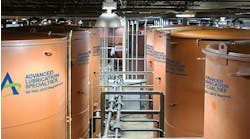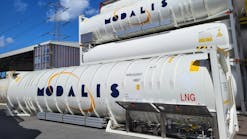EPA SPCC expert highlights key requirements and common violations for terminal owners, operators storing oil
MARK Howard knows what Environmental Protection Agency (EPA) inspectors are looking for when they go out to storage terminal facilities. The environmental scientist is the EPA’s Spill Prevention, Control and Countermeasure (SPCC) technical expert and team leader, and he’s charged with training all its SPCC inspectors.
So he also understands what makes them happy—and is eager to share that information with terminal owners and operators.
Howard, who works in the Office of Emergency Management, Regulation and Policy Development Division in Washington DC, delivered an overview of SPCC regulations, including applicability, requirements, common violations and implementation issues, in “Spill Prevention, Control and Countermeasure (SPCC) Planning: What You Need to Know” during the International Liquid Terminals Association’s 39th annual International Operating Conference.
Overview
The EPA’s congressionally mandated SPCC guidance, found in 40 CFR (Code of Federal Regulations) Part 112—which also includes the requirements for Facility Response Plans (FRPs)—lays out the rules by which the EPA attempts to prevent, prepare for and respond to oil spills that occur in and around inland waters in the United States.
The rule goes back to 1973, when it originally was part of the Federal Water Pollution Control Act, aka the Clean Water Act. The Nixon administration vetoed a version of the law but Congress overrode his veto, and Section 311 (Oil and Hazardous Substance Liability) became the basis for the EPA to write its SPCC rule.
“(Section 311) is one paragraph that basically says the president will require facilities to develop plans to prevent oil spills, and it goes in hand with the prohibition that Congress has for oil discharges,” Howard said.
The counterpart to the rule is 40 CFR Part 110, the Discharge of Oil regulation better known as the “sheen rule,” which establishes reporting requirements and reportable quantities of discharged oil that forms a sheen, or emulsion, violates water-quality standards or otherwise compels reporting to the National Response Center (NRC).
Businesses that meet the requirements for SPCC must have an FRP in place before commencing operations.
Applicability
Howard’s five quick tests for determining SPCC applicability:
The rule applies to facilities that (1) drill, produce, gather, store, process, refine, transfer, distribute, use or consume (2) oil and oil products, and are (3) non-transportation-related (ie facilities not exclusively covered by the US Department of the Interior or Department of Transportation), (4) can reasonably be expected to discharge oil in quantities that may be harmful in or upon navigable US waters or adjoining shorelines, and (5) meet capacity thresholds (more than 1,320 gallons of aboveground storage or 42,000 gallons of completely buried storage).
“Use” is a key determination in identifying oil in equipment, such as transformers or hydraulic units, as opposed to inventory flowing in or out of a container. Howard said EPA, which only regulates oil storage—transportation activity is regulated by US Department of Transportation (DOT) or the US Coast Guard—is working on a chemical counterpart to the oil discharge rule due out in August, as well as a final rule better defining the fourth determination, which currently varies by state after many reverted regulations to a pre-2015 rule by court decision.
Also, the capacity thresholds are low compared to the capacities of many storage terminals now, so EPA utilizes a tiered system of applicability levels that allows for smaller facilities in certain states to self-certify their SPCC plan.
Most ILTA member terminal owners and operators will need professional engineer (PE) certification, Howard said.
“In short, if your facility is great than 10,000 gallons, you’re looking at doing PE certification,” he said. “If it’s less than 10,000 gallons, you can self-certify, and if you’re less than 10,000 gallons with one container or no containers greater than 5,000 gallons, than you are actually able to use a (SPCC plan) template in the rule.”
FRP elements
EPA provides general provisions for everything that goes into the plan, except for administrative provisions like thresholds, definitions and secondary containment, so if a company can design a better plan, they’re free to do so, Howard said.
Key items to address in any FRP include:
• Type of oil in each container and storage capacity
• Discharge prevention measures, including procedures for routine handling of products
• Discharge or drainage controls
• Countermeasures for discharge discovery, response and cleanup
• Methods of disposal of recovered materials
• Contact list and phone numbers, including NRC
Howard said the EPA is doing more within the rule to recharacterize containers not specifically required to have size containment, like piping and transfers, and don’t fall under the bulk requirement, allowing for active measures.
“(They) essentially can be response kits, or response activity, and that’s where this section becomes pretty important, because you’re actually going to be doing a response as opposed to putting some kind of passive thing in place,” Howard said.
Other general plan requirements include facility diagrams, failure analysis, records, training, and containment for loading racks, security for non-production facilities, brittle fracture evaluations and oil-filled equipment inventory.
The failure analysis details where the oil will go if primary containment fails. Howard said it’s important to update this section with any modifications to the facility or grounds, to accurately reflect current conditions.
“Don’t say, ‘Hey, it’s going to go into secondary containment, so it’s not going to go anywhere,’” Howard insisted. “We all know things happen, and dike draining valves get left open, burrowing animals can create holes … and where is the oil going to go?”
Recordkeeping is critical in a compliance audit, providing the key to verifying a company is doing what it says it will in its plan.
General containment
General secondary containment requirements, which include the minimum precautions necessary to address a spill from piping and transfer areas not at a loading rack, define appropriate secondary containment and/or diversionary structures for all areas with the potential for the harmful discharge of oil.
“In this case, the government does not set the amount of the discharge, you guys do, and you tell us, ‘Here’s what we’re going to plan for, here’s our most likely event,’ and that’s what you put in your plan,” Howard said.
Revisions in the general rule language include the “most likely quantity of oil that would be discharged” from any part of the facility, and secondary containment may be active or passive in design, with examples of prevention measures for on-shore facilities including drip pans, sumps and collection systems.
“You don’t have to build something,” Howard said. “You can use response capability.”
Specific containment
While sections 112.1 through 112.7 set the requirements that apply to all SPCC facilities and types of oil, section 112.8 outlines specific guidelines for on-shore facilities regarding facility drainage, bulk storage containers, containment drainage requirements, facility transfer operations (piping), pumping and facility process.
Construction—Bulk storage containers with American Petroleum Institute (API) plates, meaning they were built to API Standard 12C or API 650, meet the rule requirements. No container should be used to store oil unless its material and construction are compatible with the material stored and storage conditions, such as pressure and temperature.
“Where we’re seeing a lot of issues in this particular provision is the use of underground storage tanks as above-ground storage tanks, which is not at all by code,” Howard said.
Sized containment—Secondary containment should be sized to the largest tank or tanker compartment with freeboard for a rain event (there is no freeboard requirement at a loading rack). Howard said EPA has gone back and forth with API on its 110 rule of thumb and “25-year, 24-hour storm event.” EPA’s rule says containment should be based on precipitation, and 110 bases it on the size of the container.
“Oftentimes, with larger-footprint facilities, the 110% rule of thumb correlates to a good number relative to your rain event,” Howard said. “With a smaller footprint, the 110 number becomes more of a challenge.”
The rule also includes minimum size requirements for secondary containment at loading/unloading racks, bulk storage containers, and mobile or portable bulk storage containers like drums and intermediate bulk containers (IBCs).
Integrity testing—This section requires owners/operators to test/inspect each aboveground container’s integrity on a regular basis and whenever material repairs are made, and determine, in accordance with industry standards, the appropriate qualifications of personnel performing tests and inspections, and the frequency and types of tests and inspections, taking into account container size, configuration and design.
The rule applies to large (field-constructed and field-erected) and small (shop-built) aboveground bulk storage containers; aboveground containers on, partially in (partially buried, bunkered or vaulted tanks) and off the ground, wherever located; and above-ground bulk storage containers storing any type of oil (drums, totes).
This is an ongoing expense, unlike secondary containment, Howard said, but inspections can be conducted visually, as long as inspectors follow Steel Tank Institute (STI) standard SP001, which is EPA compliant.
Overfill protection, prevention—“This is a big issue, and continues to be a big issue, with API and certainly the Chemical Safety Board as a result of the incident in Puerto Rico,” Howard said.
The rule requires facilities to follow good engineering practices to avoid discharges from container installations and provide at least one of the following: High liquid level alarms, high liquid level pump cutoff, direct audible or code signal communication between container gauger and pumping station, or a fast-response system for determining liquid level of each bulk storage container, with a person present to monitor.
Common SPCC violations
• Inadequate cross reference
• Inadequate facility diagrams (facility and diagram don’t match, missing piping and loading areas)
• Plans not addressing spill trajectory requirements
• Inadequate discharge notification form (quantity of discharged to water and media impacted)
• Missing 112.7(a) elements (the mini spill response pieces)
• Claiming impracticability, then say have contingency plan, but it’s missing
• Lack of contingency plan when required
• Notification section incomplete or dated
• Generic/non-specific information
• Plan repeats rule provisions/requirements, but isn’t specific to implementation at unique facility
• Missing information, which leads to questions
Howard said accurate cross references are “worth their weight in gold.”
“The one piece of advice I would give you, because I train all of the inspectors nationally, is if you are going to use a cross-reference, make it good, because the longer that inspector sits in your place, the more bad news it is for you,” he said. “You want them in and out quickly, and a good cross reference will do that.”
Inadequate contingency plans are another critical issue enforcement will view as a major violation, Howard said.
Implementation violations
Creating an FRP is one thing. Once the plan is in place, it is up to facility owners/operators to implement the plan.
Common implementation violations include:
• No secondary containment for the loading rack or loading area
• Inadequate or inappropriate pipe support
• Tank overfill protection not present, not functional or uninspected
• No inspection records
• No integrity testing program, or schedule for implementation or program
• Improper application of visual-only inspection regime (big for smaller facilities)
• Active containment methods cannot be implemented as described in plan
• Double walled tank non-compliance issues, including not inspecting interstice
• Actual drainage at the facility does not support the containment strategies in the plan
• Post certification modifications, alterations or construction impacts implementation
• Containment and inspection of mobile portable containers not implemented
• Using building for containment does not account for actual drainage conditions in building
Reporting
Per 40 CFR Part 110, report all oil discharges to navigable US waters or adjoining shorelines to the NRC at 800-424-8802. The federal government’s centralized reporting center is staffed 24 hours a day, and information gathered is relayed to the EPA or Coast Guard, depending on the incident’s location, and an on-scene coordinator then evaluates the situation and decides if federal emergency response is necessary.
For more information, call the oil information center at 800-424-9346.










